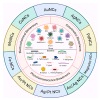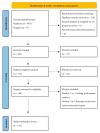Optical and Electrochemical Biosensors for Detection of Pathogens Using Metal Nanoclusters: A Systematic Review
- PMID: 40710110
- PMCID: PMC12293134
- DOI: 10.3390/bios15070460
Optical and Electrochemical Biosensors for Detection of Pathogens Using Metal Nanoclusters: A Systematic Review
Abstract
The rapid and accurate detection of pathogenic bacteria and viruses is critical for infectious disease control and public health protection. While conventional methods (e.g., culture, microscopy, serology, and PCR) are widely used, they are often limited by lengthy processing times, high costs, and specialized equipment requirements. In recent years, metal nanocluster (MNC)-based biosensors have emerged as powerful diagnostic platforms due to their unique optical, catalytic, and electrochemical properties. This systematic review comprehensively surveys advancements in MNC-based biosensors for bacterial and viral pathogen detection, focusing on optical (colorimetric and fluorescence) and electrochemical platforms. Three key aspects are emphasized: (1) detection mechanisms, (2) nanocluster types and properties, and (3) applications in clinical diagnostics, environmental monitoring, and food safety. The literature demonstrates that MNC-based biosensors provide high sensitivity, specificity, portability, and cost-efficiency. Moreover, the integration of nanotechnology with biosensing platforms enables real-time and point-of-care diagnostics. This review also discusses the limitations and future directions of the technology, emphasizing the need for enhanced stability, multiplex detection capability, and clinical validation. The findings offer valuable insights for developing next-generation biosensors with improved functionality and broader applicability in microbial diagnostics.
Keywords: bacterial detection; metal nanocluster-based biosensors; microbial infections; nanobiosensors; virus detection.
Conflict of interest statement
The authors declare no conflicts of interest.
Figures







Similar articles
-
Biosensing technology for detection and assessment of pathogenic microorganisms.Future Microbiol. 2025 Jan;20(1):57-72. doi: 10.1080/17460913.2024.2417621. Epub 2024 Oct 29. Future Microbiol. 2025. PMID: 39469851 Review.
-
Innovations in aptamer-based biosensors for detection of pathogenic bacteria: Recent advances and perspective.Talanta. 2025 Dec 1;295:128330. doi: 10.1016/j.talanta.2025.128330. Epub 2025 May 14. Talanta. 2025. PMID: 40388877 Review.
-
Nucleic acid conjugated gold nanoparticles for biosensing applications: a review.World J Microbiol Biotechnol. 2025 Jun 25;41(7):219. doi: 10.1007/s11274-025-04454-z. World J Microbiol Biotechnol. 2025. PMID: 40555853 Review.
-
Nano-modified biosensors for detection of pathogenic diseases: The prospect of smart, multiplex and point-of-care testing.ADMET DMPK. 2025 Jul 9;13(4):2799. doi: 10.5599/admet.2799. eCollection 2025. ADMET DMPK. 2025. PMID: 40786062 Free PMC article. Review.
-
Electrochemical Impedance Spectroscopy-Based Biosensors for Label-Free Detection of Pathogens.Biosensors (Basel). 2025 Jul 10;15(7):443. doi: 10.3390/bios15070443. Biosensors (Basel). 2025. PMID: 40710093 Free PMC article. Review.
Cited by
-
Metal-Organic-Framework-Based Optical Biosensors: Recent Advances in Pathogen Detection and Environmental Monitoring.Sensors (Basel). 2025 Aug 15;25(16):5081. doi: 10.3390/s25165081. Sensors (Basel). 2025. PMID: 40871944 Free PMC article. Review.
References
-
- Shen Y., Zhang Y., Gao Z.F., Ye Y., Wu Q., Chen H.Y., Xu J.J. Recent Advances in Nanotechnology for Simultaneous Detection of Multiple Pathogenic Bacteria. Nano Today. 2021;38:101121. doi: 10.1016/j.nantod.2021.101121. - DOI
Publication types
MeSH terms
LinkOut - more resources
Full Text Sources

